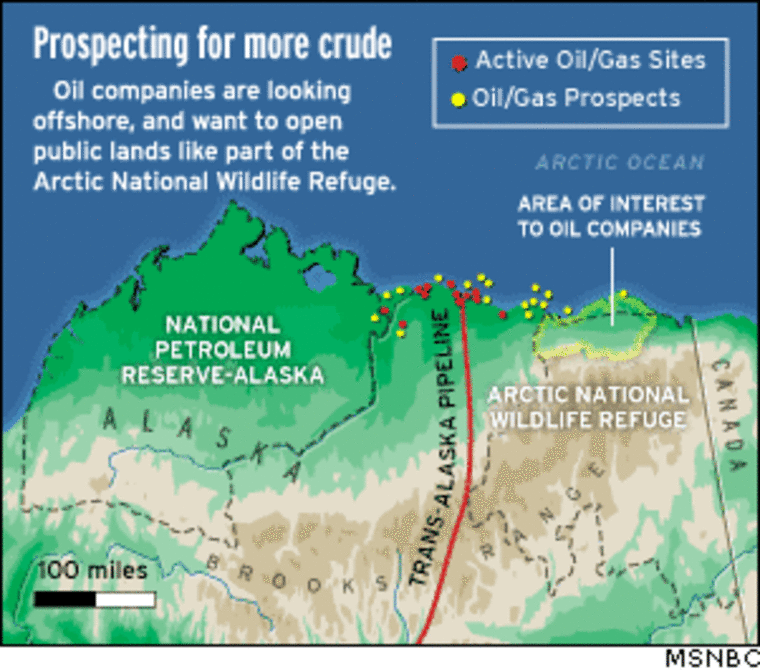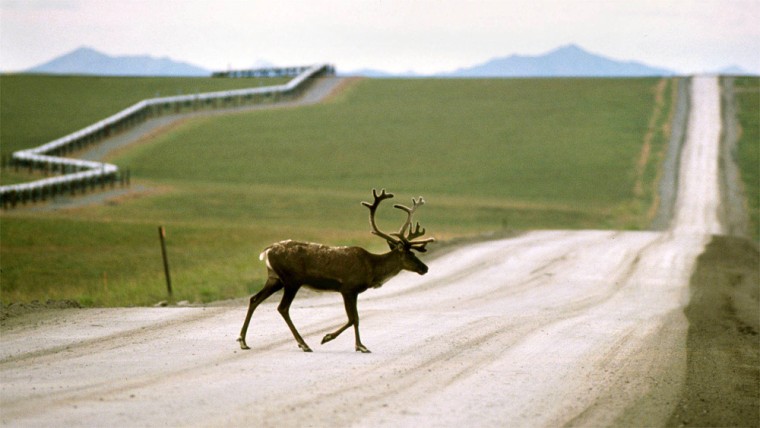Opening an Alaska wildlife refuge to oil development would only slightly reduce America’s dependence on imports and would lower oil prices by less than 50 cents a barrel, according to an analysis released Tuesday by the Energy Department.
The report, issued by the Energy Information Administration, or EIA, said that if Congress gave the go-ahead to pump oil from Alaska’s Arctic National Wildlife Refuge, the crude could begin flowing by 2013 and reach a peak of 876,000 barrels a day by 2025.
But even at peak production, the EIA analysis said, the United States would still have to import two-thirds of its oil, as opposed to an expected 70 percent if the refuge’s oil remained off the market.
At the same time, the report said new Alaska production would stem the expected dramatic decline in domestic production and extend the economic life of the Alaska oil pipeline as production from other North Slope areas declined significantly.
But even the additional domestic production would not be enough to overcome increased demand, meaning continued heavy reliance on imports, the EIA said. Currently, the United States imports about 56 percent of the oil it consumes.
Refuge a political football
Congress has grappled for years over whether to allow oil companies access to the 1.5 million-acre coastal plain in the Alaska refuge, which geologists believe harbors about 10.4 billion barrels of crude.

Last year, the House, citing the need for more domestic oil to ease the reliance on imports, gave a green light to drilling in the refuge, but the Senate refused to go along.
Many Senate Democrats, joined by a handful of moderate Republicans, have repeatedly blocked pro-drilling legislation, arguing that the refuge would be harmed ecologically. The coastal plain, which includes calving areas for caribou, is home to polar bears and other wildlife, as well as being a stopover for an annual migration of millions of birds.
Both sides see ammunition
Both sides in the issue likely will use the EIA report as ammunition in the next round of debate over energy legislation in Congress.
Rep. Richard Pombo, R-Calif., chairman of the Resources Committee, seized on the finding Tuesday that development of the refuge would boost domestic oil production by 20 percent over what it otherwise would be in 2025.
“Given America’s energy crunch, ANWR production is a must,” Pombo, who requested the analysis, said in a statement.
But environmentalists said the findings debunked arguments pushed by the Bush administration and other pro-drilling advocates that the refuge was important for national security and economic independence.
“It underscores what we’ve been saying all along, that oil drilling in the refuge would do next to nothing to actually meet America’s energy needs,” said Justin Tatham of the U.S. Public Interest Research Group, an environmental organization active in protecting the refuge from development. “... We’re still going to be reliant, if not more reliant, on foreign sources of oil.”
The EIA study also noted the importance of the refuge’s oil to Alaska.
Without the refuge’s development, oil flowing from the North Slope would fall to 500,000 barrels a day — half of current levels — by 2025 and approach levels at which the pipeline may no longer be economical to operate, the report said.
Production to increase anyway
U.S. domestic oil production will increase over the next four years, from the current 5.7 million barrels a day to 6.1 million barrels a day, largely because of additional oil coming from the Gulf of Mexico, according to the EIA report.
But after that, domestic production will decline steadily without access to the Alaskan coastal plain, and it is expected to fall to 4.6 million barrels a day by 2025. With demand increasing, imports will continue to play a larger role, jumping from 9.7 million barrels a day to nearly 16 million barrels a day, about 70 percent of what is consumed by 2025.
With the 876,000 barrels the refuge could provide a day, the reliance on imports would drop to 66 percent of domestic consumption, the EIA analysis said. The study said it would likely have little impact on world oil prices — perhaps reducing the price by 30 to 50 cents a barrel if prices were in the $27-a-barrel range.
The price of light sweet crude was $37.48 per barrel Tuesday on the New York Mercantile Exchange.
James Kendell, one of the authors of the study, said the refuge would add to domestic production, but “when you’re talking of a world oil market of over 75 million barrels a day, adding 900,000 barrels by 2025 is a drop in the bucket.”
No one is certain how much oil is beneath the Alaskan coastal plain. In assuming 876,000-barrel-a-day production, the EIA assumed the “mean” estimate provided by geologists of 10.4 billion barrels of technically recoverable reserves. Geologists say there could be less or much more. Environmentalists argue that much of that oil may not be economically recoverable if oil prices decline.
